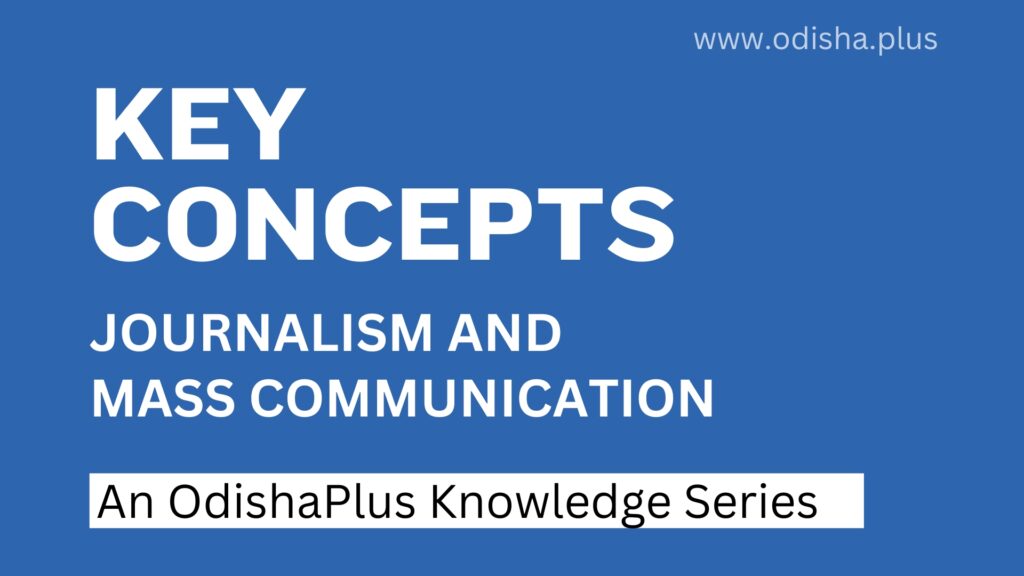OdishaPlus Knowledge Series

In the dynamic field of Mass Communication and Journalism, it’s essential to grasp the fundamental concepts that shape our understanding of media and communication. Here’s a concise overview of some key terms:
Journalism & Mass Communication:
Journalism involves the gathering, verification, and dissemination of news and information through various media platforms such as newspapers, television, radio, and online outlets. Mass Communication, on the other hand, encompasses the study of how messages are transmitted to large audiences through mass media channels.
Strategic Communication:
Strategic Communication refers to the purposeful use of communication by organizations to achieve specific goals. It involves planning, implementing, and evaluating communication strategies to influence public opinion, shape perceptions, and achieve organizational objectives.
Public Relations:
Public Relations (PR) focuses on managing the relationship between an organization and its stakeholders. PR professionals work to build a positive image for their clients or organizations through strategic communication, media relations, crisis management, and community engagement.
Corporate Communication:
Corporate Communication involves the internal and external communication efforts of a corporation. It includes conveying the organization’s values, goals, and messages to both internal stakeholders (employees) and external stakeholders (customers, investors, media, etc.).
Development Communication:
Development Communication aims to facilitate social change and development through communication strategies. It involves using media and communication tools to address issues such as poverty, healthcare, education, and environmental sustainability, with the goal of empowering communities and promoting social justice.
Advertising:
Advertising is the process of creating and delivering persuasive messages to a target audience with the aim of promoting products, services, or ideas. It involves strategic planning, creative execution, and media placement to influence consumer behavior and drive sales or brand awareness.
Social Media Communication:
Social Media Communication refers to the use of social networking platforms (such as Facebook, Twitter, Instagram, etc.) to create, share, and exchange information and ideas. It has transformed the way individuals and organizations communicate, allowing for real-time interaction and engagement with diverse audiences.
Digital Marketing:
Digital Marketing encompasses all marketing efforts that utilize digital channels such as websites, search engines, social media, email, and mobile apps to connect with current and prospective customers. It involves various tactics such as content marketing, search engine optimization (SEO), email marketing, and online advertising to reach and engage target audiences online.
Content Development:
Content development involves the creation and production of various forms of media content, including articles, videos, graphics, podcasts, and more. Professionals in this field are responsible for conceptualizing, researching, writing, and producing engaging and informative content tailored to specific audiences and platforms.
They work closely with editors, designers, producers, and other team members to ensure that the content meets the desired objectives and resonates with the target audience. Content developers may specialize in areas such as journalism, digital media, marketing, entertainment, or education, depending on their interests and expertise.
Localization:
Localization is the process of adapting content to suit the linguistic, cultural, and market-specific preferences of different regions or countries. This involves translating text, audio, video, and graphics into the local language and adjusting other elements such as date formats, currency, images, and cultural references to make the content relevant and relatable to the target audience.
Localization professionals also ensure that the content complies with local laws, regulations, and sensitivities. They play a crucial role in helping organizations reach global audiences effectively and efficiently while maintaining consistency and authenticity across different markets.
Understanding these concepts is crucial for navigating the ever-evolving landscape of Mass Communication and Journalism. As you delve deeper into your studies, remember that these terms serve as the building blocks for a successful career in this field.
(This article was generated with the assistance of artificial intelligence tools.)






















